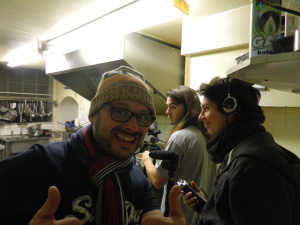The winter holidays are coming and the deadline for the final project in the SISE module gets closer and closer. For this project, my group and I have to present a 2 minutes film that contains moving image, at least 3 still images and well-recorded sound. However, neither dialogue nor characters are allowed, so basically we have to put together what we have learned from the individual assignments into a single film that shows a sense of place and blends the three parts of the module together seamlessly.
After a long debate over where to start, Christy Tattershall, one of the group members, suggested that the hustling and bustling of a cafe or pub would work quite nicely. At that moment, Craig O’Connor, another member, remembered that his cousin is head chef at a hotel’s restaurant.
The idea developed and we decided that we should make some sort of contrast between the inside of the restaurant and the kitchen, mixing the sounds of the kitchen with images from the restaurant. We wanted to show that everything looks like an act from a play, where what it’s beyond the kitchen door is made only to satisfy the clients, whereas the kitchen is dirty, people are rushing constantly, they yell, they swear, and, most of all, they are more human in that particular environment. This contrast between the two worlds, separated by a single door, became the idea behind our final project.
Unfortunately, we missed the days meant to be used for filming the project, due to some unexpected events that were taking place at our production’s location. Our access was restricted in that period, so we had to work together as a group to find a solution. Eventually, we focused on planning every detail for the first day of shooting, in our hope to finish the production process in a single day.
When we finally got to the location, my group and I took every shot and recorded every distinguishable sound that we could. However, this happened late in the evening, and we had access only to the kitchen. I was the one recording the sound. I used a portable audio recorder and shotgun microphone on a boom pole to get the chopping and all the sounds the appliances produced. Christy took the shots, while Corinne Thomas coordinated us and took pictures of the location. At the end of the day, we only covered the kitchen and we still needed a lot more footage and sound.


A new day was required solely for production, but because we missed the free days, we had to attend tutorials at university in the remaining time until the deadline, so our group had to divide in two smaller groups. Christy and Craig went to get some footage of the restaurant, while Bethany Timms, Corinne, and I told the tutors about what we were planning to do and about our progress with the project. Their feedback helped us in getting an overall picture of how our film should look like in the end.
In conclusion, things didn’t go according to plan, for one reason or another, but good teamwork and constructive feedback put our idea in a new light. We hope that the problems we encountered are going to be solved soon and we are looking forward to reach the desired result before the deadline.





